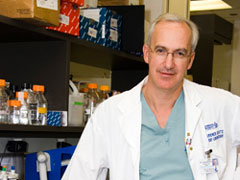Spring Up
By Laura Pratt
This spring, more than $3.6 million in operating grants was awarded to Sunnybrook Research Institute (SRI) scientists in recognition of outstanding shows in autumn competitions. Operating grants are foundational to the ability of a scientist to do her research. In common parlance, they are known as a researcher’s “bread and butter.” They fund the day-to-day running of a given research project.
The Heart and Stroke Foundation of Ontario (HSFO) has awarded $1.2 million to five SRI scientists: Dr. Alexander Dick, Dr. Robert Fowler, Dr. Krista Lanctôt, Dr. Sheldon Tobe and Dr. Burton Yang.
The National Cancer Institute of Canada (NCIC) has awarded $807,624 to three SRI scientists: Dr. David Goertz, Dr. Laurence Klotz and Dr. Arun Seth. In addition, the NCIC has awarded the 2008 Harold E. Johns Studentship Award—a $2,500 prize—to Jelena Tomic, a doctoral student in the molecular and cellular biology lab of SRI senior scientist Dr. David Spaner.
The Canadian Breast Cancer Research Alliance (CBCRA) has awarded $408,866 to Dr. Jean-Philippe Pignol.
And the Canadian Breast Cancer Foundation (CBCF) has awarded $1.2 million to three SRI researchers: Dr. Jorge Filmus, Dr. Jean-Philippe Pignol and Dr. Cari Whyne.
These scientists’ research spans an array of subject areas.
Yang, for example, is working on the role of extracellular matrix molecules in tumour growth and angiogenesis regulated by microRNAs. With the HSFO grant—$82,060 a year for three years—his lab will investigate how microRNA miR-17 regulates angiogenesis. They will study the effects of miR-17 on endothelial cell life span and wound healing by targeting fibronectin, and research the effect of miR-17 on angiogenesis during wound repair and tumour formation.
Tobe will apply his HSFO funds—$75,627 a year for three years—to the Harmony study, which is examining a relaxation strategy known as mindfulness-based stress relaxation, a program for anxiety and cancer pain reduction that can lower blood pressure as part of adjusting one’s lifestyle. Tobe and his lab are recruiting 100 people over the next year to participate in this research which, he says, “will hopefully lead to the day when physicians can refer patients with high blood pressure to trained health practitioners who can deliver standardized effective lifestyle therapy.”
Klotz, meanwhile, will apply his NCIC grant—$153,174 over two years—to research on magnetic-resonance-imaging-guided transurethral ultrasound thermotherapy of the prostate. This is a unique initiative—homegrown at Sunnybrook—involving the urology and imaging physics departments. “It has a lot of potential to be a new, quicker, safer, more effective treatment for localized prostate cancer,” Klotz says of the thermotherapy. The grant will fund an initial clinical trial in 15 patients having surgery for prostate cancer.
And Filmus will use his CBCF funding—$360,000 over three years—to further his research into glypican-3 (GPC3), a protein he’s discovered to be produced by the normal mammary gland, but not by breast cancers. What’s more, he’s shown that GPC3 can inhibit the growth of breast cancer cells, indicating that this protein can act as a tumour suppressor. “Our goal is to investigate the mechanism by which GPC3 inhibits the growth of breast cancer,” says Filmus, who hypothesizes that the growth-inhibitory activity of GPC3 in breast cancer is due to its ability to block a growth factor called Hedgehog, which stimulates the expansion of several cancer types, including breast cancer.
Dick will spend his HSFO award money ($76,877 a year for three years) on researching the role of naturally occurring repair cells—endothelial progenitor cells—in mending the heart after a heart attack. Mindful of the way these cells decrease in number and potency in response to the risk factors that bring on the heart attack, Dick will concentrate on the effect of removing them in a diabetic animal model and modifying them so as to regain their ability to patch up the heart. “These studies,” says Dick, “will help in developing new treatments to repair the heart after a heart attack.”
“We applaud the success of these faculty members in what are extremely competitive funding programs,” says Dr. Michael Julius, vice-president of research at Sunnybrook Health Sciences Centre. “The investment by our funding agency partners will help us to achieve our shared goal of making care better for patients everywhere.”
PDF / View full media release »


